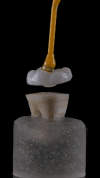A Comparative Study of the Marginal Fit of Endocrowns Fabricated From Three Different Computer-Aided Design/Computer-Aided Manufacturing (CAD/CAM) Ceramic Materials: An In Vitro Study
- PMID: 37292110
- PMCID: PMC10246431
- DOI: 10.7759/cureus.40081
A Comparative Study of the Marginal Fit of Endocrowns Fabricated From Three Different Computer-Aided Design/Computer-Aided Manufacturing (CAD/CAM) Ceramic Materials: An In Vitro Study
Abstract
Introduction: The marginal seal and adaptation are important factors for successful restoration. An inadequate marginal seal can lead to bacterial microleakage, plaque accumulation, and eventually treatment failure This in vitro study aimed to compare the marginal gap of endocrowns fabricated from three different computer-aided design/computer-aided manufacturing (CAD/CAM) ceramic materials.
Methods: Thirty extracted mandibular molars were selected for the study. Endocrown preparations were completed after root canal treatment. Teeth were divided into three groups to receive endocrowns fabricated of lithium disilicate ceramic (IPS-e.max CAD, Ivoclar Vivadent AG, Schaan, Liechtenstein), zirconia-reinforced lithium silicate ceramic (VITA Suprinity®, VITA Zahnfabrik, Bad Säckingen, Germany), and polymer-infiltrated ceramic (VITA Enamic®, VITA Zahnfabrik). The digital impressions were transferred to the design software to construct the endocrowns. The endocrowns were milled and cemented. The marginal fit was examined using a digital camera stereomicroscope at a magnification of 80X. Images were transferred to Image-J software (National Institutes of Health, Bethesda, Maryland, United States) to measure the marginal gap.
Results: One-way ANOVA showed a significant difference in the marginal gap between the different ceramic groups (P=0.006). Tukey's Honest Significant Difference (HSD) post-hoc test showed that VITA Suprinity had significantly higher gap width values than VITA Enamic (P=0.005). No significant differences in gap width values were found between VITA Enamic and IPS e.max CAD or between VITA Suprinity and IPS e.max CAD (P>0.05).
Conclusion: The marginal gap of endocrown restorations varies with different CAD/CAM materials (zirconia-reinforced lithium silicate glass-ceramic, polymer-infiltrated hybrid ceramic, and lithium disilicate glass-ceramic), but are all within clinically acceptable marginal gap width.
Keywords: endocrown; ips e.max cad; marginal fit; marginal gap; vita enamic; vita suprinity.
Copyright © 2023, Attar et al.
Conflict of interest statement
The authors have declared that no competing interests exist.
Figures



Similar articles
-
Fracture Strength of Endocrowns Fabricated From Three Different Computer-Aided Design/Computer-Aided Manufacturing Ceramic Materials: An In-Vitro Study.Cureus. 2023 Jul 7;15(7):e41531. doi: 10.7759/cureus.41531. eCollection 2023 Jul. Cureus. 2023. PMID: 37426406 Free PMC article.
-
A Comparative Analysis of Marginal Adaptation Values between Lithium Disilicate Glass Ceramics and Zirconia-Reinforced Lithium Silicate Endocrowns: A Systematic Review of In Vitro Studies.Med Sci Monit. 2023 Dec 27;29:e942649. doi: 10.12659/MSM.942649. Med Sci Monit. 2023. PMID: 38148601 Free PMC article.
-
Effect of different CAD-CAM materials on the marginal and internal adaptation of endocrown restorations: An in vitro study.J Prosthet Dent. 2020 Jan;123(1):128-134. doi: 10.1016/j.prosdent.2018.10.024. Epub 2019 Apr 23. J Prosthet Dent. 2020. PMID: 31027958
-
Comparative Evaluation of the Internal and Marginal Adaptations of CAD/CAM Endocrowns and Crowns Fabricated from Three Different Materials.Int J Prosthodont. 2021 March/April;34(3):341–347. doi: 10.11607/ijp.6389. Epub 2020 Dec 19. Int J Prosthodont. 2021. PMID: 31856266
-
Biomechanical behavior of all-ceramic endocrowns fabricated using CAD/CAM: A systematic review.J Prosthodont Res. 2024 Jan 16;68(1):50-62. doi: 10.2186/jpr.JPR_D_22_00296. Epub 2023 Jun 7. J Prosthodont Res. 2024. PMID: 37286503
Cited by
-
Application of one-piece endodontic crowns fabricated with CAD-CAM system to molars.Jpn Dent Sci Rev. 2024 Dec;60:81-94. doi: 10.1016/j.jdsr.2023.12.005. Epub 2024 Jan 20. Jpn Dent Sci Rev. 2024. PMID: 38303746 Free PMC article. Review.
-
Fracture Strength of Endocrowns Fabricated From Three Different Computer-Aided Design/Computer-Aided Manufacturing Ceramic Materials: An In-Vitro Study.Cureus. 2023 Jul 7;15(7):e41531. doi: 10.7759/cureus.41531. eCollection 2023 Jul. Cureus. 2023. PMID: 37426406 Free PMC article.
-
A Comparative Analysis of Marginal Adaptation Values between Lithium Disilicate Glass Ceramics and Zirconia-Reinforced Lithium Silicate Endocrowns: A Systematic Review of In Vitro Studies.Med Sci Monit. 2023 Dec 27;29:e942649. doi: 10.12659/MSM.942649. Med Sci Monit. 2023. PMID: 38148601 Free PMC article.
References
-
- A systematic review of single crowns on endodontically treated teeth. Stavropoulou AF, Koidis PT. J Dent. 2007;35:761–767. - PubMed
-
- Identifying and reducing risks for potential fractures in endodontically treated teeth. Tang W, Wu Y, Smales RJ. J Endod. 2010;36:609–617. - PubMed
-
- Microhardness of light- and dual-polymerizable luting resins polymerized through 7.5-mm-thick endocrowns. Gregor L, Bouillaguet S, Onisor I, Ardu S, Krejci I, Rocca GT. J Prosthet Dent. 2014;112:942–948. - PubMed
-
- All-ceramic or metal-ceramic tooth-supported fixed dental prostheses (FDPs)? A systematic review of the survival and complication rates. Part I: single crowns (SCs) Sailer I, Makarov NA, Thoma DS, Zwahlen M, Pjetursson BE. Dent Mater. 2015;31:603–623. - PubMed
LinkOut - more resources
Full Text Sources
Research Materials
Miscellaneous
